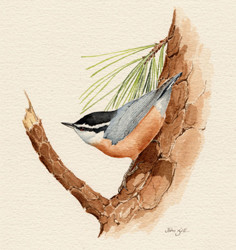Find a Bird - BBA1
Breeding Bird Atlas 1 Species Accounts
Red-breasted Nuthatch
Sitta canadensis
Egg Dates
April 20 to June 20
Number of Broods
one

Until the midtwentieth century, this species was considered a denizen of northern boreal forests and a regular breeder only in Berkshire County and only a casual to rare and local nester east to Plymouth and Essex counties. Historically, most observers east of Worcester County recorded it primarily as a migrant. The Red-breasted Nuthatch is also well known for its periodic and sometimes large winter irruptions. Interestingly, the Atlas project revealed it to breed fairly evenly throughout much of the state, in limited numbers even to the tip of Cape Cod at Provincetown, as well as at Martha’s Vineyard and Nantucket. Following an irruption winter, it appears that some individuals may augment the local population by remaining in Massachusetts to breed.
Spring migration is generally lighter than that in fall, perhaps partly due to winter mortality. Movement begins in late March and continues into mid-May, by which time territories have usually been established. Late migrants are presumably birds that breed well to the north. The courtship of the Red-breasted Nuthatch is seldom noted, but the few references are consistent. The song consists of a rapid repetition of the short tin trumpet wa-wa-wa calls, and a series may be repeated as many as 16 times per minute. Sometimes, the wings and tail are held slightly open. Frequently, this activity is performed in a spruce or other conifer and is difficult to observe. Members of a pair or group communicate with various hit, it, or yna notes, given singly or in a series.
The nest cavity is excavated in soft, rotten snags or stumps from 5 to 70 feet above the ground. The birds generally construct their own chambers but may use old woodpecker holes or even nest boxes. Seven nests in Massachusetts were located as follows: 1 in a bird box at 7 feet (ACB), 1 in a dead poplar stub at 12 feet (Bagg & Elliot 1937), 1 in a dead Paper Birch, 1 in a dead Gray Birch (Brewster 1906), 2 in rotting White Pine stumps at 12 feet and 15 feet, respectively (Blodget), and 1 in a rotten branch of a live White Pine at 25 feet (Meservey). Pitch from nearby conifers typically is smeared around the hole, presumably as a protective measure, and the birds have been observed to fly straight into the hole without landing so as to avoid getting fouled with the substance. The bottom of the cavity is lined with bark, moss, rootlets, fur, and feathers. Nest building has been observed in Massachusetts from April 3 to May 10 (Bagg & Elliot 1937, TC, Meservey).
The clutch of four to eight (average five or six) eggs is primarily incubated by the female for 12 days. One Massachusetts nest contained eight eggs on May 23 (DKW). Both parents feed the young, which leave the nest 18 to 21 days after hatching. Nestlings have been reported in Massachusetts from May 26 to July 2 and families with three or four young from June 1 to July 29 (TC, BOEM, Brewster 1906, Meservey).
Birds often appear well away from breeding areas in late July, after the molt period. By August, when these nuthatches begin to move in earnest and numbers are swelled with the young of the year, interesting things can happen, and individuals can be seen flycatching, creeping about the roofs of buildings, or scouring coastal rocks at low tide. Peak migrant numbers occur from late September to mid-October. Most move farther south, but in some winters many will remain, depending partly on cone production because in all seasons the Red-breasted Nuthatch prefers coniferous woods. In other winters, the species may be virtually absent, giving it those irregular and irruptive labels that make such species just a little more interesting.
Map Legend and Data Summary
Atlas 1 data collected from 1975-1979


Note: uncommon in coniferous woodlands of central and western areas; less common in eastward region
James Berry



